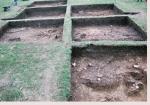Summary (English)
ARCHAEOLOGICAL EXPLORATIONS NEAR THE VILLAGE OF BOROVAN (Georgi Ganetsovski – ganecovski_ar@abv.bg) The area of the settlement was c. 12,000 sq. m. Two Early Chalcolithic strata and one stratum from the Transition (Proto-Bronze) period were documented and a defensive ditch with a palisade, surrounding the settlement from three sides, was discovered during the previous excavations. In 2010, a burned clay wall of structure No. 1 was explored in Sector South. The finds included ceramic vessels from the Early Chalcolithic period (Gradeshnitsa Culture), fragments from a zoomorphic terracotta figurine and an anthropomorphic terracotta figurine, knucklebones, a bone awl, a bone spatula, bone jewelry, retouched flint plates and combined flint tools. The Early Chalcolithic structures were demolished by constructions from the Transition (Proto-Bronze) period. Probably, during the construction of the settlement in the first half of the 4 millennium BC, the new inhabitants cleaned up and leveled the terrain, partly destroying the remains from the Early Chalcolithic period. The stratum from the Transition (Proto-Bronze) period was 40 – 90 cm thick. Three ovens and pit No. 2 were explored. The finds included sherds (Galatin Culture), terracotta loom weights, retouched flint plates and flint arrowheads, knucklebones, bone awls, a sea shell, an amulet from a tooth, a copper awl, stone pestles, animal bones and an occasional Roman denarius of the 2nd century BC. Remains from a burned building were discovered in trench P21: a pile of burned fragmentary wattle-and-daub, six postholes, a clay construction with a quern and carbonized grain, a dolium and a pile of carbonized grain. The finds included two terracotta loom weights, a bone shuttle, bone tools, flint scrapers, a bead from marbleized limestone, three small ceramic vessels, sherds and animal bones. Two radiocarbon dates from the site provided the following chronology: 3891 – 3666 BC and 3959 – 3776 BC, corresponding to the Transition (Proto-Bronze) period.
- Georgi Ganetsovski - Museum of History – Vratsa
Director
Team
Research Body
- Museum of History – Vratsa






![Download [PDF]](/excavation/skins/fasti/images/results/download_sml.png)
